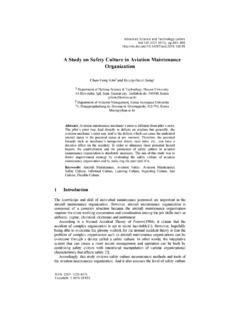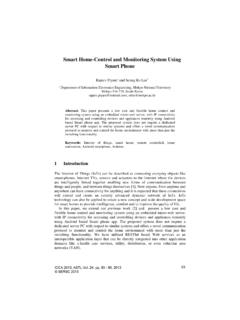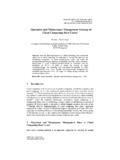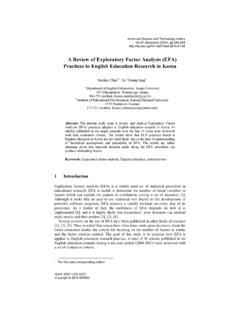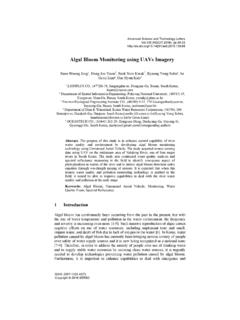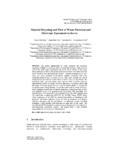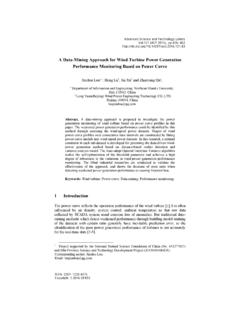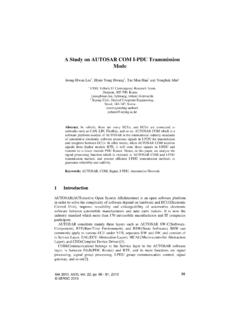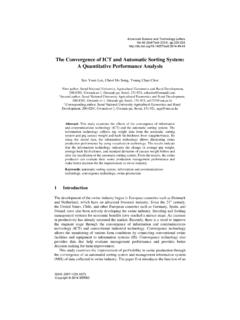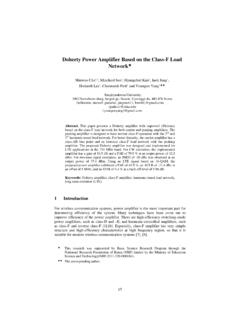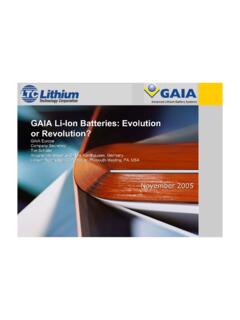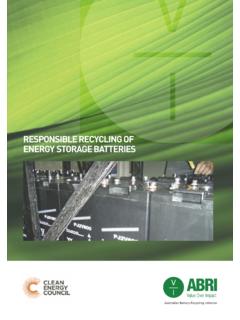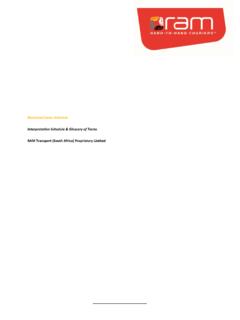Transcription of A Novel Design for Lithium ion Battery cooling …
1 Advanced Science and Technology Letters (GST 2016), A Novel Design for Lithium ion Battery cooling using mineral Oil Mahesh Suresh Patil1 , Jae-Hyeong Seo2, You-Ma Bang1, Dae-Wan Kim2, Gihan Ekanayake1, Gurpreet Singh1, Hak-Min Kim1, Yong-Hwan Choi3, and Moo-Yeon Lee1,*. 1. Dong-A University, 37, Nakdong-daero 550beon-gil, Saha-gu, Busan, Republic of Korea 2. NTF Tech Company, 37, Nakdong-daero 550beon-gil, Saha-gu, Busan, Republic of Korea 3. Hyundai Motor Group, 772-1, Jangduk-Dong, Hwaseong-Si, Gyeonggi-Do, 445-706, Republic of Korea Abstract. The Battery thermal management system has become an important aspect of the development of electric vehicles (EVs) which are widely considered as a promising option instead of internal combustion based vehicles (ICEs) for reducing the climate change effects.
2 Particularly, advances in Lithium ion batteries with high energy density are considered key elements for wide spread acceptance of EVs. Batteries with larger energy densities exhibit the thermal issues, which creates decreased performances at higher operating temperatures and eventually turning thermal runaway into fire or explosion. In this paper, a Novel Design is presented with mineral oil as a coolant with channel guide. The temperature distribution is recorded at various coolant mass flow rates and pressure drop variation is discussed. Keywords: Lithium ion, Battery thermal management system, cooling , mineral oil 1 Introduction The energy crisis and rapidly degrading climate condition have prompted to slowly phase out fossil fuel based ICE vehicles and adopt more environment friendly electric vehicles.
3 The Battery technology is one of the core technologies of EVs industry. The EV travel range has been under focus as limiting factor for penetration of EV in the market as commercial vehicle. Therefore, considerable research is being carried out to enhance the EV travel range by adding more batteries with higher energy densities. Many studied have reflected that Lithium ion Battery performance decreases when operated outside the operating temperature of 0-40 C [1, 2]. This creates a serious problem of Battery thermal management system (BTMS), as higher energy density in Battery dissipates large heat and that needs to be removed continuously and efficiently ISSN: 2287-1233 ASTL.
4 Copyright 2016 SERSC. Advanced Science and Technology Letters (GST 2016). during the EV Battery charging and discharging. In addition, it is desirable to keep the temperature uniformity within Battery pack less than 5 C [3, 4]. Previously, air- cooling and liquid cooling have been considered as coolants for BTMS. The air- cooling although easier to construct and operate with low maintenance, the system becomes rather bulkier due to lower thermal conductivity of air. The direct and in-direct cooling methods include the liquid as coolant (especially water or water-ethylene glycol mixture).
5 Indirect cooling uses fins, which are used to transfer heat from Battery cells to coolant [5]. In direct cooling , small coolant channels are developed in plate attached to Battery cell [6]. In this paper, a Novel Battery cooling method is designed and proposed. mineral oil is used as cooling fluid and a channel guide is developed for channelizing mineral oil flow and maintaining the distance between cells while cells start swelling. Due to electrically non- conductive nature, mineral oil can be a good option as coolant for electrical devices. The parametric study is conducted considering the mass flow rates.
6 2 Numerical Simulation The Battery pack model is developed using commercial CAD software. The mesh development and simulation is conducted in commercial CFD software ANSYS 17. [7]. The pouch cell size considered is 300 (l) x 100 (w) x 10 (t) mm3. One module under consideration consists of 16 pouch cells and 1 Battery pack under consideration consists of 3 modules. The mineral oil properties are shown in table 1 [8]. The viscosity of mineral oil is quite high which creates requirement of higher pumping power compared to water. Table 2 shows the initial condition of the numerical simulation.
7 The mass flow rates of 1, 5 and 10 LPM (Liter/min) are considered. Table 1. mineral oil property [8]. Property Specifications Density (kg/m3) 924. Specific Heat Capacity (J/kg K) 1900. Dynamic viscosity (Pa s) Thermal conductivity (W/m K) Table 2. Numerical simulation conditions. Property Specifications Working fluid mineral oil cooling method Coolant circulation Heat generation rate 30000 W/m3 (~6W/cell). Mass flow rate (LPM) 1, 5, 10. Copyright 2016 SERSC 165. Advanced Science and Technology Letters (GST 2016). 3 Results and Discussion The results discussed using temperature distribution and pressure drop discussions.
8 Fig. 1 shows the comparison of the temperature distribution along the single pouch cell plane. The maximum temperature observed is C, C and C. whereas the minimum temperature observed is C, C and C, for 1, 5, 10 LPM, respectively. The temperature difference between maximum and minimum are C, C and C for 1, 5 and 10 LPM, respectively. It is very important to keep the temperature uniformity within 3 C along each of the pouch cell as well as in overall Battery pack within 5 C. The results of the numerical simulation shows that temperature uniformity is well maintained below 1 C.
9 The interesting point to note here is that, although the mass flow rate increased 10 times, the maximum cell temperature decreased only This underlines that the mineral oil mass flow rate has very limited effect of the thermal performance of the cell. The advantage of this is that the lower mass flow rates would also give the similar performance as higher mass flow rates. (a). (b). (c). Fig. 1. Temperature distribution along Battery cell in plane for different mass flow rates (a) 1. 166 Copyright 2016 SERSC. Advanced Science and Technology Letters (GST 2016).
10 LPM (b) 5 LPM (c) 10 LPM. Fig. 2. Pressure head loss with respect to different mass flow rate The similar discussions extended to pressure drop analysis. Pressure drop is a crucial parameter to judge the cost effectiveness of cooling system using liquid coolant. The fig. 2 shows the pressure drop variation with respect to mass flow rate. The pressure head loss across inlet and outlet for 10 LPM is 4 times higher when compared to 5. LPM. The increase of pressure drop with increase in mass flow rate attributes to high viscosity of the mineral oil. 4 Conclusion In this study, the numerical investigation was carried to check the feasibility and analyze the oil cooling performance for Lithium ion Battery pack with mineral oil as coolant.
